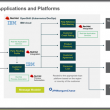Composable banking beyond the core
In my previous column post, I gave an overview of what composable banking is and highlighted the great work the Banking Industry Architecture Network (BIAN) is doing in defining banking services.

The scope for composable banking goes way beyond core banking
Because I focused so much on core and digital banking, it occurred to me that I may not have made it clear to those unfamiliar with BIAN that its service definition covers every aspect of the business of banking. That means covering how our IT operations are run, marketing/sales, human resources, investor relations and so on. This is very much in line with the famous Jeff Bezos dictate that every part of Amazon’s tech landscape must have an API.
The scope for composable banking goes way beyond core banking and is another reason why banks should look beyond core banking vendors for the composable business architecture. An immediate question would be why should a bank make something disparate like staff recruitment systems or debt collection a service? For me, the short answer is innovation.
This could be in many forms:
New revenue streams: If the bank becomes really good at any of these other areas it could decide to offer that as a service to its customers. Why not “sell” its platforms for debt collection so its SME banking customers can manage their debts better? Or offer recruitment-as-a-service so business customers can improve their hiring?
Cost efficiency: For larger banks that are siloed – by brands, product or customer segment, for example – having centralised services available through the cloud means they can more easily share the same operational services rather than sourcing them separately and duplicating spend.
Service effectiveness: To simplify many of these operational services, many companies have used monolithic ERP solutions which, like legacy core banking solutions, have tied companies into their platform. Now modern ERP solutions enable composable operational business services, allowing customers to move between providers for specific services more easily.
Modern core banking vendors have started to assimilate an ecosystem or marketplace of third-party solutions that banks can compose their banking platform from. These have generally been limited to pure banking solutions, not general business operations solutions.
However, solutions like TomorrowX are starting to fill this gap to enable banks to create a fully composable bank and not just the banking system. TomorrowX is targeting a much broader range of services than just operations and banking and has a catalogue of more than 500 components that can be utilised.
While this sounds like a lot, the opportunity is much greater. The possibility is for the range of components to outnumber the total amount of apps on any of today’s mobile app stores (there are currently just under five million between Apple and Google).
This “component-based architecture” is not new, with many using the analogy of Lego bricks to describe their vision. However, a number of things have changed.
The cloud enables provisioning of these components without having to go through long installation and configuration processes or having to buy specific hardware and operating systems.
Software-as-a-service (SaaS) pricing models now allow companies much more flexibility to pay for infrastructure and software, enabling them to test/trial and then scale more cost effectively.
In the past, developers had to worry about HOW to connect to these components, but with APIs, this is taken care of and now they can focus their time and attention elsewhere.
A move to a composable approach presents a huge opportunity for banks to simplify one of their biggest perennial technology challenges, and that is systems integration. The largest have thousands of systems, even the smallest have hundreds. Not all of these are integrated – some should be but can’t be due to cost and complexity. The need to innovate and improve exacerbates the system integration problem.
I’m not saying that this is all super easy and cheap. It’s a bit like mobile phones: they had been around for a couple of decades but really took off as the hardware got cheaper and faster, bandwidth improved and the software became easier to use and open to enable development and innovation. Even then it has taken more than 10 years after the first iPhone for more people to have a smartphone than not.
I’m just saying that the vision of a composable ORGANISATION is more than just core banking alone, and that it is more realisable today than it has ever been.
About the author
Dharmesh Mistry has been in banking for 30 years and has been at the forefront of banking technology and innovation. From the very first internet and mobile banking apps to artificial intelligence (AI) and virtual reality (VR).
He has been on both sides of the fence and he’s not afraid to share his opinions.
He is CEO of AskHomey, which focuses on the experience for households, and an investor and mentor in proptech and fintech.
Follow Dharmesh on Twitter @dharmeshmistry and LinkedIn.
Read all his “I’m just saying” musings here.












































